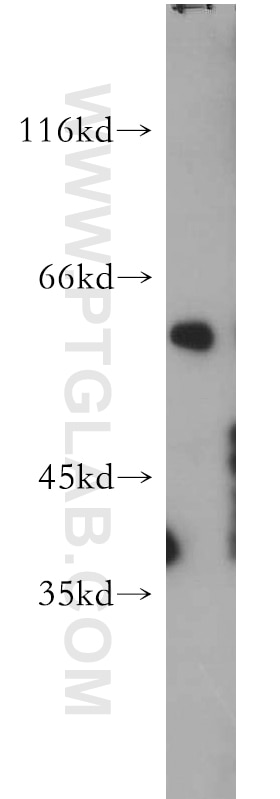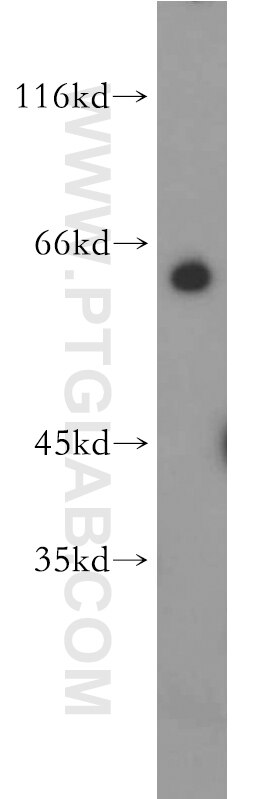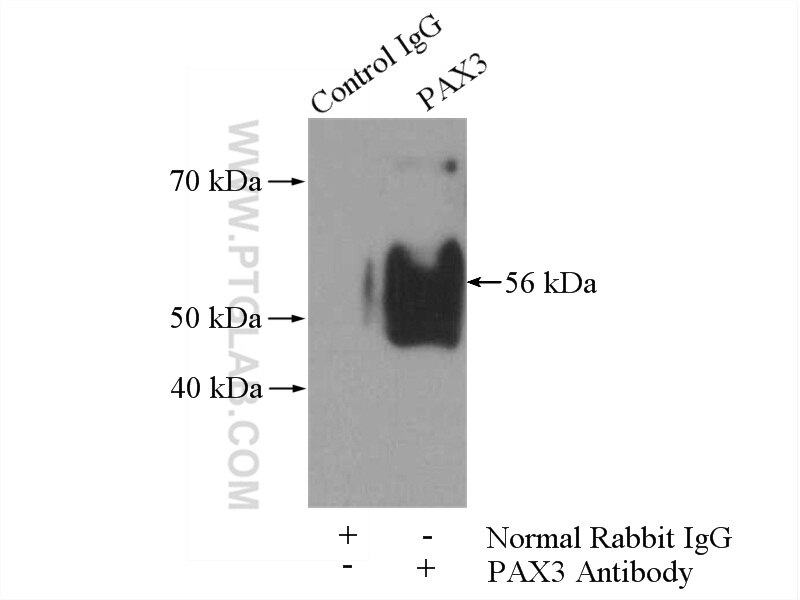Anticorps Polyclonal de lapin anti-PAX3
PAX3 Polyclonal Antibody for WB, IP, ELISA
Hôte / Isotype
Lapin / IgG
Réactivité testée
Humain, rat, souris et plus (1)
Applications
WB, IHC, IP, ELISA
Conjugaison
Non conjugué
N° de cat : 21386-1-AP
Synonymes
Galerie de données de validation
Applications testées
| Résultats positifs en WB | tissu cutané de souris, cellules HEK-293 |
| Résultats positifs en IP | tissu cutané de souris |
Dilution recommandée
| Application | Dilution |
|---|---|
| Western Blot (WB) | WB : 1:500-1:3000 |
| Immunoprécipitation (IP) | IP : 0.5-4.0 ug for 1.0-3.0 mg of total protein lysate |
| It is recommended that this reagent should be titrated in each testing system to obtain optimal results. | |
| Sample-dependent, check data in validation data gallery | |
Applications publiées
| WB | See 2 publications below |
| IHC | See 1 publications below |
Informations sur le produit
21386-1-AP cible PAX3 dans les applications de WB, IHC, IP, ELISA et montre une réactivité avec des échantillons Humain, rat, souris
| Réactivité | Humain, rat, souris |
| Réactivité citée | Humain, souris, Hamster |
| Hôte / Isotype | Lapin / IgG |
| Clonalité | Polyclonal |
| Type | Anticorps |
| Immunogène | PAX3 Protéine recombinante Ag16021 |
| Nom complet | paired box 3 |
| Masse moléculaire calculée | 484 aa, 53 kDa |
| Poids moléculaire observé | 56-60 kDa |
| Numéro d’acquisition GenBank | BC101301 |
| Symbole du gène | PAX3 |
| Identification du gène (NCBI) | 5077 |
| Conjugaison | Non conjugué |
| Forme | Liquide |
| Méthode de purification | Purification par affinité contre l'antigène |
| Tampon de stockage | PBS with 0.02% sodium azide and 50% glycerol |
| Conditions de stockage | Stocker à -20°C. Stable pendant un an après l'expédition. L'aliquotage n'est pas nécessaire pour le stockage à -20oC Les 20ul contiennent 0,1% de BSA. |
Informations générales
PAX3, a transcription factor and multifunctional regulatory protein, is normally expressed during embryonic development. In the nervous system, PAX3 is involved in neural tube closure, neural crest development, and peripheral neuron differentiation. In the present study, PAX3 was reported as a novel regulator of GFAP transcription, and the overexpression and suppression of PAX3 could inhibit and promote NSC differentiation, respectively. In muscle development, PAX3 ensures the survival of myogenic progenitor cells with Pax3-expressing progenitors giving rise to both skeletal and smooth muscle cells. PAX3 also has a well-established role in the development of melanocytes during embryogenesis, and has recently been characterized as a molecular switch in the mature melanocyte. Mutations in PAX3 can cause Waardenburg syndrome.
Protocole
| Product Specific Protocols | |
|---|---|
| WB protocol for PAX3 antibody 21386-1-AP | Download protocol |
| IP protocol for PAX3 antibody 21386-1-AP | Download protocol |
| Standard Protocols | |
|---|---|
| Click here to view our Standard Protocols |
Publications
| Species | Application | Title |
|---|---|---|
Birth Defects Res Cigarette smoke induced neural tube defects by down-regulating noggin expression. | ||
Neurochem Int Cycloleucine induces neural tube defects by reducing Pax3 expression and impairing the balance of proliferation and apoptosis in early neurulation | ||
Stem Cells Int Noggin Combined With Human Dental Pulp Stem Cells to Promote Skeletal Muscle Regeneration |




